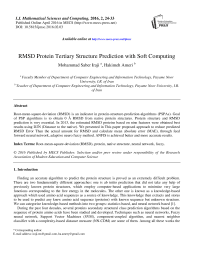RMSD Protein Tertiary Structure Prediction with Soft Computing
Автор: Mohammad Saber Iraji, Hakimeh Ameri
Журнал: International Journal of Mathematical Sciences and Computing(IJMSC) @ijmsc
Статья в выпуске: 2 vol.2, 2016 года.
Бесплатный доступ
Root-mean-square-deviation (RMSD) is an indicator in protein-structure-prediction-algorithms (PSPAs). Goal of PSP algorithms is to obtain 0 Å RMSD from native protein structures. Protein structure and RMSD prediction is very essential. In 2013, the estimated RMSD proteins based on nine features were obtained best results using D2N (Distance to the native). We presented in This paper proposed approach to reduce predicted RMSD Error Than the actual amount for RMSD and calculate mean absolute error (MAE), through feed forward neural network, adaptive neuro fuzzy method. ANFIS is achieved better and more accurate results.
Root-mean-square-deviation (RMSD), protein, native structure, neural network, fuzzy
Короткий адрес: https://sciup.org/15010206
IDR: 15010206
Список литературы RMSD Protein Tertiary Structure Prediction with Soft Computing
- Saha, S. (2008). Protein Secondary Structure Prediction by Fuzzy Min Max Neural Network with Compensatory Neurons (Doctoral dissertation, Indian Institute of Technology, Kharagpur).
- E. Sakk, A. Alexander, On the variability of neural network classfication measures in the protein secondary structure prediction problem, Appl. Comput. Intell. Soft Comput. (2013) 1–9. Available online at 4/16/2015.(http://www.hindawi.com/journals/acisc/2013/794350/).
- Tan, Y. T., &Rosdi, B. A. (2015). FPGA-based hardware accelerator for the prediction of protein secondary class via fuzzy K-nearest neighbors with Lempel–Ziv complexity based distance measure. Neurocomputing, 148, 409-419.
- Babaei, S., Geranmayeh, A., &Seyyedsalehi, S. A. (2010). Protein secondary structure prediction using modular reciprocal bidirectional recurrent neural networks. Computer methods and programs in biomedicine, 100(3), 237-247.
- Zhou, Z., Yang, B., &Hou, W. (2010). Association classification algorithm based on structure sequence in protein secondary structure prediction. Expert Systems with Applications, 37(9), 6381-6389.
- Qu, W., Sui, H., Yang, B., &Qian, W. (2011). Improving protein secondary structure prediction using a multi-modal BP method. Computers in biology and Medicine, 41(10), 946-959.
- Hassan, R., Othman, R. M., Saad, P., &Kasim, S. (2011). A compact hybrid feature vector for an accurate secondary structure prediction. Information Sciences, 181(23), 5267-5277.
- Babaei, S., Geranmayeh, A., &Seyyedsalehi, S. A. (2012). Towards designing modular recurrent neural networks in learning protein secondary structures.Expert Systems with Applications, 39(6), 6263-6274.
- Zangooei, M. H., &Jalili, S. (2012). Protein secondary structure prediction using DWKF based on SVR-NSGAII. Neurocomputing, 94, 87-101.
- Hayat, M., Tahir, M., & Khan, S. A. (2014). Prediction of protein structure classes using hybrid space of multi-profile Bayes and bi-gram probability feature spaces. Journal of theoretical biology, 346, 8-15.
- Patel, M. S., &Mazumdar, H. S. (2014). Knowledge base and neural network approach for protein secondary structure prediction. Journal of theoretical biology, 361, 182-189.
- Chen, Y., Xu, J., Yang, B., Zhao, Y., & He, W. (2012). A novel method for prediction of protein interaction sites based on integrated RBF neural networks.Computers in biology and medicine, 42(4), 402-407.
- Mishra, A., Rana, P. S., Mittal, A., &Jayaram, B. (2014). D2N: Distance to the native. Biochimica et BiophysicaActa (BBA)-Proteins and Proteomics, 1844(10), 1798-1807.
- Iraji, M. S., &Motameni, H. (2012). Object Oriented Software Effort Estimate with Adaptive Neuro Fuzzy use Case Size Point (ANFUSP). International Journal of Intelligent Systems and Applications (IJISA), 4(6), 14.


